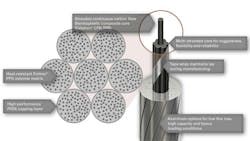Carbon-Core Overhead Transmission Conductor Unveiled
Utilities looking for greater flexibility, reliability and single-failure tolerance for critical transmission lines now have an affordable carbon-fiber option in the new Southwire C7TM Overhead Conductor. The multi-stranded composite core using advanced polymers, resins and thermoplastics from Celanese delivers increased performance and a service life in excess of 40 years.
Southwire has been developing the C7 Overhead Conductor for the past seven years, creating a transmission conductor with nearly double the capacity and less sag than the same diameter ACSR. . The new overhead conductor has a stranded continuous carbon-fiber thermoplastic composite core for rugged flexibility and reliability. The carbon fibers are embedded in a heat-resistant Fortron® PPS polymer matrix and capped with a layer of high-performance PEEK. The design allows for minimum sag at higher power transfer, and the stranded core means there is no single point of failure for the overhead conductor.
“Southwire has a 60-year history of quality and innovation when it comes to supplying utilities with transmission lines,” said Mark Lancaster, Southwire Director of Overhead Transmission Engineering. “Our goal in creating the Southwire C7 Overhead Conductor was to give customers an alternative to our standard ACSR and HS285® transmission line solutions that offered flexibility, reliability and ruggedness to stand up to a variety of difficult environments.”
Southwire partnered with Celanese, a leading manufacturer of carbon fiber–reinforced thermoplastics, to develop Celstran® CFR-TPR using high-performance Fortron PPS and PEEK thermoplastics. Conductor using this new high-performance material is engineered to provide performance, value and durability. C7 Overhead Conductor delivers superior thermal performance that cuts costs for new line installation or reconductoring.
The Southwire C7 Overhead Conductor’s use of high-performance thermoplastics means long life in demanding applications. The conductor is crew friendly and can be installed using standard line tools on existing structures and foundations with traditional two-piece compression connectors.
